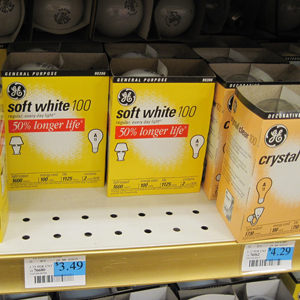
This post originally appeared on California Watch, a KQED content partner and a project of the Center for Investigative Reporting.
By Susanna Rust
Say goodbye to your 100-watt incandescent light bulbs. On Jan. 1, it’ll become increasingly challenging to find one on a store shelf in California.
That’s because the state has ordered a phaseout of the high energy-consuming light bulb.
The state is pressing to have the old incandescents replaced with newer, more efficient bulbs, such as compact fluorescents, halogens and light-emitting diode light bulbs, or LEDs.
And beginning in 2012, 100-watt incandescents will be off the shelves completely.
As is typical, California is getting a jump-start on a trend that will begin nationwide in a few years. Three years ago, the federal government enacted legislation to phase out the old bulbs. National phaseout will begin in 2014. Other countries, such as Australia, Ireland and Cuba have already banned them.
There are drawbacks to the new bulbs, however.
Fluorescent bulbs, or CFLs, contain mercury, which can be harmful to the environment and to human health. Therefore, the bulbs must be handled differently than other household waste.
Local hazardous waste centers, and some hardware stores, will take spent fluorescent bulbs for recycling. The other bulbs contain chemicals such as bromine and iodine. These do not require special recycling.
Consumers looking to find a replacement for the old 100-watt bulb will likely choose the energy-efficient 72-watt bulb, which will provide an equal amount of light but uses less power.
“The consumer will still be able to use the product and have the same results to light an office, a desk lamp, a hallway. A 72-watt light bulb will still provide the same service as the old 100-watt bulb,” Adam Gottlieb, a spokesman for the California Energy Commission, told the Scripps Howard news service. “Consumers really need to know they won’t see any difference. The difference they’ll see is a more energy-efficient bulb.”
The California Energy Commission website has a user-friendly FAQ page about the new light bulb standards and how the rules affect consumers.
5 thoughts on “CA Says “So Long, Energy-Sucking Light Bulbs””
Comments are closed.

Hi,
Yesterday FedEx delivered my 15 year supply of 100 watt bulbs, I wanted to beat the ban. I ordered them from Amazon. I wonder if Amazon will not be allowed to ship 100 watt bulbs to California after the first of the year.
Good question. We’ll check on that. Just curious: How many bulbs is a 15-year supply for you?
Word from the CEC is that Californians can still mail-order 100-watt incandescents from out of state if they so wish.
One of the big problems with compact fluorescent lightbulbs is that they emit light in a few bands, not across the spectrum like an incandescent bulb… which glows by black body radiation.
Halogens too glow with a broad spectrum.
We use CFL on the perimeter of the house but we’ve given them up inside because they do affect how well we see detail. We went with halogens, even though they cost money and use up more energy, because they are easier on the eyes and I can read books without having to squint and wear cheater glasses.
Incandescent lights are, IMHO, yellowish in comparison but don’t kid yourself, they are downright cheap. The price of one halogen light pays for several incandescent and the difference in power.
And, CFLs do not replace incandescents.. that’s a myth. Nevermind the pollution of those bulbs.
IMHO opinion, dimmers are the solution to save power.
As usual, the Sacramento politicians have shown how DIM witted they are.
Ay….
> As usual, the Sacramento politicians have shown how DIM witted they are.
I don’t think so, not this time. First of all, the 72W bulbs that were advocated in the article are not CFLs – that wattage draw is much too high for a CFL (with light intensity on par with 100W bulbs). The 72W “EcoVantage” bulbs contain no mercury, have no warm-up time, and are fully dimmer compatible.
Finally, the ban on 100W will be enacted by the federal government starting in 2012. Dimmer switches cannot sidestep that legislation.